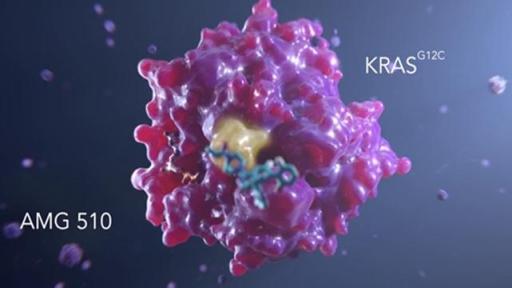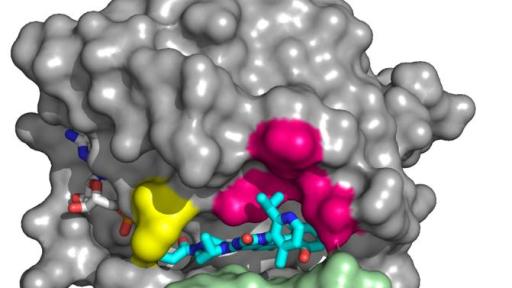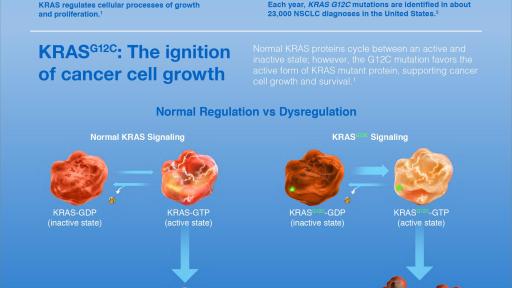The Discovery Of Amgen’s Novel Investigational KRASG12C Inhibitor AMG 510 Published In Nature
Publication Showcases how First-to-Clinic Investigational AMG 510 Exploits a Cryptic Groove of the Previously Undruggable KRAS Protein Surface
THOUSAND OAKS, Calif. (Oct. 30, 2019) — Amgen (NASDAQ:AMGN) today announced a publication in Nature unveiling the discovery of AMG 510, a small molecule inhibitor of KRASG12C being investigated as a treatment for a variety of solid tumors with KRAS G12C mutation. AMG 510 is the first investigational KRASG12C inhibitor to advance to the clinic and is currently enrolling in a potentially registrational Phase 2 study.
Titled “The Clinical KRASG12C Inhibitor AMG 510 Drives Anti-Tumor Immunity,” the paper highlights novel structural insights that led to the discovery of AMG 510, the preclinical evidence of AMG 510 activity, its potential ability to induce tumor-cell killing as both a monotherapy and in combination with other therapies, and its impact on the immune system that may render tumor cells particularly sensitive to immunotherapy. Early evidence of clinical activity of AMG 510 is also presented in the paper.
“We are pleased to share how our team of scientists at Amgen were the first to exploit the previously hidden groove on the protein surface to finally identify a potential drug against this important oncogenic protein,” said David M. Reese, M.D., executive vice president of Research and Development at Amgen. “These scientific insights, coupled with superb molecular engineering, paved the way for AMG 510 to be first to clinic, where it has demonstrated early evidence of clinical activity.”
KRAS, identified over 30 years ago as a proto-oncogene, is one of the most frequently mutated oncogenes in human cancer.1,2 Amgen researchers first identified the novel histidine 95 (H95) groove located on an inactive KRASG12C protein. Through extensive compound screening and structure-based design, AMG 510 emerged as the top investigational candidate from the optimization of a series of H95 groove-binding molecules. It is designed to irreversibly bind to KRASG12C protein and permanently lock it in an inactive state, leading to inhibition of tumor cell growth in KRASG12C driven tumors. In preclinical experiments, AMG 510 demonstrated favorable potency and selectivity, and induced regression in mice bearing KRASG12C mutated tumors.
“There is a significant unmet need for tumor-selective therapies that minimize a negative impact on normal cells, and many patients diagnosed with KRAS-mutated solid tumors have typically faced a challenging prognosis with limited targeted treatment options,” said David S. Hong, M.D., one of the paper’s authors, AMG 510 clinical study investigator and deputy chair, Department of Investigational Cancer Therapeutics, Division of Cancer Medicine at University of Texas MD Anderson Cancer Center, Houston. “This publication shows investigational AMG 510 has high selectivity in non-clinical experiments, binding only to KRASG12C out of more than 6,000 proteins and likely contributing to the absence of dose-limiting toxicities in the clinical study to date, supporting the potential for an encouraging safety profile.”
The U.S. Food and Drug Administration (FDA) granted Orphan Drug Designation to AMG 510 for previously treated metastatic non-small cell lung cancer (NSCLC) and colorectal cancer with KRAS G12C mutation and Fast Track Designation for previously treated metastatic NSCLC with KRAS G12C mutation. Additional data from the ongoing Phase 1 clinical trial evaluating AMG 510 was recently presented at the 2019 World Conference on Lung Cancer hosted by the International Association for the Study of Lung Cancer and at the European Society for Medical Oncology 2019 Congress, both of which were held in Barcelona, Spain.
About KRAS
The subject of more than three decades of research, the RAS gene family are the most frequently mutated oncogenes in human cancers.1,2 Within this family, KRAS is the most prevalent variant and is particularly common in solid tumors.2 A specific mutation known as KRAS G12C accounts for approximately 13% of non-small cell lung cancers, three to five percent of colorectal cancers and one to two percent of numerous other solid tumors.3 Approximately 30,000 patients are diagnosed each year in the United States with KRAS G12C-driven cancers.4 KRASG12C has been considered “undruggable” due to a lack of traditional small molecule binding pockets on the protein. Amgen is exploring the potential of KRASG12C inhibition across a broad variety of tumor types.
About Amgen Oncology
Amgen Oncology is searching for and finding answers to incredibly complex questions that will advance care and improve lives for cancer patients and their families. Our research drives us to understand the disease in the context of the patient's life – not just their cancer journey – so they can take control of their lives.
For the last four decades, we have been dedicated to discovering the firsts that matter in oncology and to finding ways to reduce the burden of cancer. Building on our heritage, Amgen continues to advance the largest pipeline in the Company's history, moving with great speed to advance those innovations for the patients who need them.
At Amgen, we are driven by our commitment to transform the lives of cancer patients and keep them at the center of everything we do.
For more information, follow us on www.twitter.com/amgenoncology.
About Amgen
Amgen is committed to unlocking the potential of biology for patients suffering from serious illnesses by discovering, developing, manufacturing and delivering innovative human therapeutics. This approach begins by using tools like advanced human genetics to unravel the complexities of disease and understand the fundamentals of human biology.
Amgen focuses on areas of high unmet medical need and leverages its expertise to strive for solutions that improve health outcomes and dramatically improve people's lives. A biotechnology pioneer since 1980, Amgen has grown to be one of the world's leading independent biotechnology companies, has reached millions of patients around the world and is developing a pipeline of medicines with breakaway potential.
For more information, visit www.amgen.com and follow us on www.twitter.com/amgen.
Forward-Looking Statements
This news release contains forward-looking statements that are based on the current expectations and beliefs of Amgen. All statements, other than statements of historical fact, are statements that could be deemed forward-looking statements, including any statements on the outcome, benefits and synergies of the acquisition of Otezla® (apremilast), including anticipated Otezla sales growth and the timing of non-GAAP EPS accretion, as well as estimates of revenues, operating margins, capital expenditures, cash, other financial metrics, expected legal, arbitration, political, regulatory or clinical results or practices, customer and prescriber patterns or practices, reimbursement activities and outcomes and other such estimates and results. Forward-looking statements involve significant risks and uncertainties, including those discussed below and more fully described in the Securities and Exchange Commission reports filed by Amgen, including our most recent annual report on Form 10-K and any subsequent periodic reports on Form 10-Q and current reports on Form 8-K. Unless otherwise noted, Amgen is providing this information as of the date of this news release and does not undertake any obligation to update any forward-looking statements contained in this document as a result of new information, future events or otherwise.
No forward-looking statement can be guaranteed and actual results may differ materially from those we project. Discovery or identification of new product candidates or development of new indications for existing products cannot be guaranteed and movement from concept to product is uncertain; consequently, there can be no guarantee that any particular product candidate or development of a new indication for an existing product will be successful and become a commercial product. Further, preclinical results do not guarantee safe and effective performance of product candidates in humans. The complexity of the human body cannot be perfectly, or sometimes, even adequately modeled by computer or cell culture systems or animal models. The length of time that it takes for us to complete clinical trials and obtain regulatory approval for product marketing has in the past varied and we expect similar variability in the future. Even when clinical trials are successful, regulatory authorities may question the sufficiency for approval of the trial endpoints we have selected. We develop product candidates internally and through licensing collaborations, partnerships and joint ventures. Product candidates that are derived from relationships may be subject to disputes between the parties or may prove to be not as effective or as safe as we may have believed at the time of entering into such relationship. Also, we or others could identify safety, side effects or manufacturing problems with our products, including our devices, after they are on the market.
Our results may be affected by our ability to successfully market both new and existing products domestically and internationally, clinical and regulatory developments involving current and future products, sales growth of recently launched products, competition from other products including biosimilars, difficulties or delays in manufacturing our products and global economic conditions. In addition, sales of our products are affected by pricing pressure, political and public scrutiny and reimbursement policies imposed by third-party payers, including governments, private insurance plans and managed care providers and may be affected by regulatory, clinical and guideline developments and domestic and international trends toward managed care and healthcare cost containment. Furthermore, our research, testing, pricing, marketing and other operations are subject to extensive regulation by domestic and foreign government regulatory authorities. Our business may be impacted by government investigations, litigation and product liability claims. In addition, our business may be impacted by the adoption of new tax legislation or exposure to additional tax liabilities. If we fail to meet the compliance obligations in the corporate integrity agreement between us and the U.S. government, we could become subject to significant sanctions. Further, while we routinely obtain patents for our products and technology, the protection offered by our patents and patent applications may be challenged, invalidated or circumvented by our competitors, or we may fail to prevail in present and future intellectual property litigation. We perform a substantial amount of our commercial manufacturing activities at a few key facilities, including in Puerto Rico, and also depend on third parties for a portion of our manufacturing activities, and limits on supply may constrain sales of certain of our current products and product candidate development. In addition, we compete with other companies with respect to many of our marketed products as well as for the discovery and development of new products. Further, some raw materials, medical devices and component parts for our products are supplied by sole third-party suppliers. Certain of our distributors, customers and payers have substantial purchasing leverage in their dealings with us. The discovery of significant problems with a product similar to one of our products that implicate an entire class of products could have a material adverse effect on sales of the affected products and on our business and results of operations. Our efforts to acquire other companies or products and to integrate the operations of companies we have acquired may not be successful. A breakdown, cyberattack or information security breach could compromise the confidentiality, integrity and availability of our systems and our data. Our stock price is volatile and may be affected by a number of events. Our business performance could affect or limit the ability of our Board of Directors to declare a dividend or our ability to pay a dividend or repurchase our common stock. We may not be able to access the capital and credit markets on terms that are favorable to us, or at all.
The scientific information discussed in this news release related to Amgen’s product candidates is preliminary and investigative. Such product candidates are not approved by the U.S. Food and Drug Administration, and no conclusions can or should be drawn regarding the safety or effectiveness of the product candidates.
CONTACT: Amgen, Thousand Oaks
Trish Hawkins, 805-447-5631 (Media)
Jessica Akopyan, 805-447-0974 (Media)
Arvind Sood, 805-447-1060 (Investors)
1 Cox A, et al. Drugging the undruggable RAS: Mission possible? Nat Rev Drug Discov. 2014 Nov;13(11):828-51.
2 Fernandez-Medarde A, Santos E. Ras in cancer and developmental diseases. Genes Cancer. 2011 Mar;2(3):344-58.
3 Lipford, JR. Pre-clinical development of AMG 510: the first inhibitor of KRASG12C in clinical testing. Oral presentation at AACR 2019, Atlanta, GA. March 29-April 3, 2019.
4 Stephen AG, et al. Dragging ras back in the ring. Cancer Cell. 2014 Mar 17;25(3):272-81.



